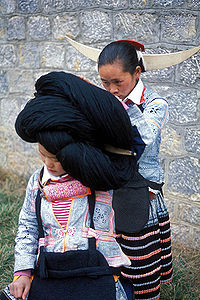Our website is made possible by displaying online advertisements to our visitors.
Please consider supporting us by disabling your ad blocker.
Miao people
苗族 Hmong / Hmub / Xongb / ab Hmaob m̥oŋ˦˧ / m̥ʰu˧ / ɕoŋ˧˥ / a˥˧m̥ao˥˧ | |
|---|---|
 Headdress of the Long-horn Miao—one of the small branches of Miao living in the 12 villages near Zhijin County, Guizhou | |
| Total population | |
| 11–12 million | |
| Regions with significant populations | |
| 9,426,007 (2010) | |
| 1,393,547 (2019) | |
| 595,028 (2015) | |
| 299,000 (2015)[1][2] | |
| 250,070 (2015) | |
| 13,000 | |
| 2,190[3] | |
| Languages | |
| Hmongic languages, Kim Mun language, Mandarin, Cantonese, Linglinghua, Maojia, Suantang, Vietnamese, Tai–Kadai languages (Lao and Thai), French | |
| Religion | |
| Miao folk religion Minorities: Taoism, Atheism, Irreligion, Christianity, Buddhism | |
| Miao people | |||||||||||||||||||||||||
|---|---|---|---|---|---|---|---|---|---|---|---|---|---|---|---|---|---|---|---|---|---|---|---|---|---|
| Chinese | 苗族 | ||||||||||||||||||||||||
| |||||||||||||||||||||||||

Miao is a word that the Chinese use to designate some ethnic minority groups living in southern China and Mainland Southeast Asia. Miao is thus officially recognized by the Chinese government as one of the largest ethnic minority groups that has more than 56 official ethnicities and dialects. The Miao live primarily in the mountains of southern China. Their homeland encompasses the provinces of Guizhou, Yunnan, Sichuan, Hubei, Hunan, Guangxi, Guangdong, and Hainan. Some sub-groups of the Miao, most notably the Hmong people, have migrated out of China into Southeast Asia (Myanmar, Northern Vietnam, Laos, and Thailand). Following the communist takeover of Laos in 1975, a large group of Hmong refugees resettled in several Western nations, mainly in the United States, France, and Australia.
Miao is a Chinese term, while the component groups of people have their own autonyms, such as (with some variant spellings) Hmong, Hmu, Xong (Qo-Xiong), and A-Hmao. These people (except those in Hainan) speak Hmongic languages, a subfamily of the Hmong–Mien languages including many mutually unintelligible languages such as the Hmong, Hmub, Xong and A-Hmao.[4]

Not all speakers of the Hmongic languages belong to the Miao. For example, the speakers of the Bunu and Bahengic languages are designated as the Yao, and the speakers of the Sheic languages are designated as the She and the Yao.
The Kem Di Mun people in Hainan, despite being officially designated as Miao people, are linguistically and culturally identical to the Kim Mun people in continental China who are classified as a subgroup of the Yao.[5]
- ^ Hoeffel, Elizabeth M.; Rastogi, Sonya; Kim, Myoung Ouk; Shaid, Hasan (2012). "The Asian Population: 2010" (PDF) (Brief). U.S. Census Bureau.
- ^ "Hmong in the U.S. Fact Sheet".
- ^ Coughlan, James E. (2010). "The Countries of Birth and Ethnicities of Australia's Hmong and Lao Communities: An Analysis of Recent Australian Census Data" (PDF). Journal of Lao Studies. 1 (1): 55–85.
- ^ Ratliff, Martha. "Hmong-Mien Languages". Encyclopedia Britannica. Archived from the original on 2021-04-17. Retrieved 2021-04-19.
- ^ Huang, Guifang 黄贵方 (2016-09-22). 探访海南苗族"金第璊". Wénshān xīnwén wǎng 文山新闻网 (in Chinese). Retrieved 2021-04-21.
Previous Page Next Page


